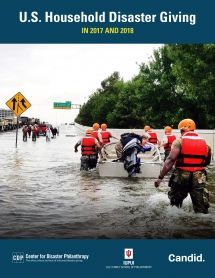First comprehensive study of household giving for disaster aid uncovers patterns, preferences, and practices of individuals’ charitable giving in wake of costliest year for U.S. disasters
The Center for Disaster Philanthropy (CDP), Candid and the Indiana University Lilly Family School of Philanthropy at IU Indianapolis announced the release of the first comprehensive study on household donations to disasters, the U.S. Household Disaster Giving in 2017 and 2018 Report. This study reveals new data on U.S. households’ disaster giving and answers many of the questions most often asked about patterns, preferences and practices of individual charitable giving for disaster aid efforts.
In 2017 and 2018, the U.S. experienced the first- and fourth-most costly years of major natural disasters on record. These disasters included Hurricanes Harvey, Irma and Maria (2017), Hurricanes Florence and Michael (2018) and devastating wildfires in California both years—in addition to major flooding events, tornadoes and winter storms. In the two years combined, the country was affected by 30 natural disasters that each caused more than $1 billion in damage.
Using recent survey data from a nationally representative sample of U.S. households, the report presents findings on the patterns of household disaster giving and the factors driving individuals to donate after disasters. It provides insights for foundations and other nonprofit organizations to engage individuals to help with disaster aid effectively.
“It is striking to see the level of individual support after disasters and the report confirms trends we see in our work—there are considerably fewer donations to fund ongoing recovery efforts,” said Robert G. Ottenhoff, president and CEO of the Center for Disaster Philanthropy. “This is particularly relevant now. The 2019 Atlantic hurricane season is fast-approaching yet, communities impacted by the 2017 storms (and prior years) are still working to recover. This indicates an imperative to raise awareness, particularly among individuals, of the need to create sustained funding in order to build stronger, more resilient communities.”
Key data insights from the report include:
- Approximately 30% of U.S. households made a disaster-related donation in 2017 (31%) and in 2018 (29%).
- Top motivations for disaster giving were:
- Magnitude of a disaster—the scale of an event and the number of people affected—was the top motivating factor for giving to disaster aid efforts.
- Personal connections to the location of a disaster and media coverage.
- Over a fifth (22%) of U.S. households donated to disaster aid efforts in both years; 18% of these donors regularly supported disaster aid efforts or considered disaster giving as part of their annual charitable budgets.
- Continued support waned in years following a disaster:
- In 2018, about 5% of U.S. households donated to provide continued relief from 2017 disasters, and another nearly 3% donated to continue alleviating impacts of disasters that occurred prior to 2017.
- In 2017, only 2% donated to support recovery from disasters that occurred in earlier years.
- Approximately three-fifths (61%) of disaster aid donor households made both financial and in-kind gifts.
- About 12 percent of U.S. households volunteered to assist with disaster aid efforts in at least one of the two years.
“Substantial anecdotal evidence testifies to Americans’ generosity in the wake of recent, large-scale catastrophes,” said Una Osili, Ph.D., associate dean for research and international programs at the Lilly Family School of Philanthropy. “However, much remains unknown about individuals’ decision making and contributions after major disasters. This study’s new, empirical data shed valuable light on these philanthropic behaviors.”
“In the last two years, we’ve seen numerous disasters cause devastation in the U.S. and across the globe. This report provides key insight into the motivations and decisions of individuals in the U.S. who gave to disaster relief in 2017 and 2018. Looking at data from the survey, we can infer that U.S. households donated roughly $10 billion to disaster aid efforts in both years. This is a significant amount, and we hope this report is a first step to helping donors think more strategically about future disaster-related investments,” said Larry McGill, vice president of knowledge services at Candid.
Key findings of the report and their implications will be discussed on Wednesday, May 21, at 2:00 p.m. ET/ 1:00 p.m. CT during a free webinar, “U.S. Household Giving: How Donors Responded to 2017 & 2018 Disasters.”
About Candid
Foundation Center and GuideStar joined forces in 2019 to become Candid, a 501c3 nonprofit organization. Every year, millions of nonprofits spend trillions of dollars around the world. Candid finds out where that money comes from, where it goes, and why it matters. Through research, collaboration, and training, Candid connects people who want to change the world to the resources they need to do it. Candid’s data tools on nonprofits, foundations, and grants are the most comprehensive in the world. Find out more at candid.org.
About the Center for Disaster Philanthropy (CDP)
The Center for Disaster Philanthropy’s mission is to transform disaster giving by providing timely and thoughtful strategies to increase donors’ impact during domestic and international disasters. CDP is currently managing six Disaster Funds on behalf of corporations, foundations and individuals through targeted, holistic and localized grantmaking. In the face of intensifying natural disasters and worsening humanitarian crises, CDP also works to raise awareness of the urgent need to support the full lifecycle of disasters, from mitigation and preparedness to long-term recovery and resilience, particularly among vulnerable populations. For more information, visit http://disasterphilanthropy.org, call (202) 595-1026 or tweet us @funds4disaster.
About the Indiana University Lilly Family School of Philanthropy
The Lilly Family School of Philanthropy at IU Indianapolis is dedicated to improving philanthropy to improve the world by training and empowering students and professionals to be innovators and leaders who create positive and lasting change. The school offers a comprehensive approach to philanthropy through its academic, research and international programs and through The Fund Raising School, Lake Institute on Faith & Giving, Mays Institute on Diverse Philanthropy and the Women’s Philanthropy Institute. Follow us on Twitter @IUPhilanthropy or “Like” us on Facebook.


